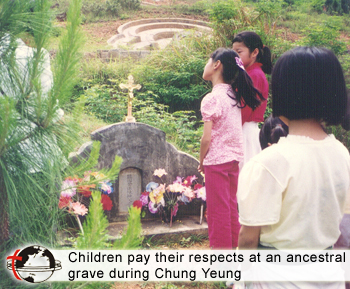
China Bridge (神州橋樑)_2006/Nov
Remembering, forgetting, or trivialising the departed
Before the Roman Republic became the Roman Empire, Cicero referred to the dead as the “silent majority.” That statement was correct even before Christ. No one knows how many people have ever lived, but the cumulative total is probably a dozen times the current global population. In China, where many provinces were densely settled 2000 years ago, the ratio has to be higher.
Our ancestors are silent. There were no tape recorders a few generations ago. The written word remains – sometimes. Paper burns, mildews or crumbles. Poor people have always been buried simply, without being noted in history books. For the rich and powerful, words chiselled into rock eventually faded, especially in wetter climates. Rich tombs were looted overnight, while over the centuries, tombstones cracked, fell down, and were recycled for building material. After visiting a cemetery, Thomas Gray wrote, “All await the inevitable hour. The paths of glory lead but to the grave.”
Despite laborious efforts to trace family trees, the trail eventually becomes cold. New biotech companies offer DNA testing for a fee, but the results sometimes contain an unpleasant surprise. If a white woman in the United States of America (USA) reads her report and sees a gene or two from Africa, or a Chinese man discovers an ancestor from Japan, they will not be amused. They may even ask in vain for a refund. The truth hurts. At best, DNA provides only vague clues as to how long ago an ancestor lived. No genealogy will ever be complete. We will never even know the majority of the names, let alone their biographies.
In recent generations, photos have kept memories alive and there are ways to enhance faded photos. Digital images by the billion are saved on computers. But with changing software and the obsolescence of hardware, will people a century from now be able to view our pictures?
Lurking in the background is an ancient fear “Even our name will be forgotten in time” (Wis. 2:4). The fear of meaninglessness leads the wicked to indulgence and cruelty (Wis. 2:7-20).
The need to remember the dead in China
But why think such morbid thoughts? Shouldn’t the dead just be forgotten? Shouldn’t the living seize the day, focus only on the here and now, eat, drink and be merry? In reply, every traditional society, and every religion, shouts “No! Do not forget the dead!”
In the Doctrine of the Mean, (中庸), one of the Four Books (四書) of Confucianism, we read, “To treat the dead as dead, as if they no longer existed, to care for them no longer and to forget them would be inhuman; to treat them as though they were living would be unreasonable… That man is wise who fulfills all his duties and honors the ancestors, keeping them at a respectful distance.” At the beginning of Chinese civilization, the ancestors were close to the living, close enough to benefit from sacrifices and to consult by divination. Perhaps that was too close for comfort.
By 500 BC, the distance between the living and the dead was growing. One way that even Confucius (孔子) was kept at a respectful distance was by having only his name, not his painting or statue, prominently displayed in his memorial halls. For Daoists, Buddhists and the folk religion, temples have always been filled with countless paintings, mosaics and statues. But for the government-sponsored cult of the Sage, the decorations have been only calligraphy, flowers and geometrical figures. China recently chose one copyrighted image of Confucius as the only image to be displayed in Confucius Institutes around the world. Beijing funds Confucius Institutes to promote the teaching of Chinese language and culture, for the enrichment of people of other nations. The 21st century is more visual and less focussed on books, so even Confucius now needs one recognisable image to protect his brand. When Mao Zedong was alive, who could have imagined that Confucius would once again symbolise China to the rest of the world?
Catholics remember the dead
The fear of annihilation and meaninglessness leads wicked people to indulge in cruelty (Wis. 2:7-20). By contrast, hope comes from looking beyond the grave. “The souls of the just are in the hand of God, and no torment shall touch them” (Wis. 3:1).
In a dispute about the resurrection of the dead, Jesus stated that God is “not the God of the dead but of the living” (Mt. 22:32). The communion of saints is part of the Apostles Creed. The souls of martyrs participate in the liturgy at God’s altar in heaven (Rev. 6:9-11) and the First Eucharistic Prayer, the Roman Canon, names 23 martyrs from after the time of the apostles. With the end of persecution, martyrdom was no longer an option, but the heroic effort to imitate Christ by caring for the poor or by withdrawing from the world into a monastic life captured the imagination of the faithful. Some saints were remembered only locally, while the fame of others travelled over land and sea. Christian art soon depicted the Virgin Mary and the saints. In some cases, images were misunderstood and misused, leading to the bitter iconoclast controversy. So in the year 787, the Seventh Ecumenical Council met in Nicea and declared that icons were to be honored and venerated, but not adored. By that time, the western Church was already keeping a festival in honor of all the saints. In 834 AD, Pope Gregory III fixed November 1 as the date. The earliest reference to praying for the dead is found in 2 Mac. 12:38-46. November 2, the day after All Saints, was a sensible choice for All Souls Day.
The less said about death, the better?
Marxism has little to say about death. With no God, no Buddha, no angels, no devils, no heaven, no hell, no reincarnation and no soul, what is there to discuss? In Old China, families often went deeply into debt for a beautifully carved coffin, set aside good farmland for graves, paid a geomancer to select a lucky hour for internment in a site with good fung shu (風水), hired a choir of chanting monks and vied to impress the community with an elaborate banquet afterwards. By contrast, after 1949, the ideal memorial service became a simple gathering of family and co-workers. Someone praised the contribution of the deceased to the building of New China. There was a minute of silence followed by cremation. The new funeral ritual was a ghost of its former self. Many cemeteries and the few golf courses were later returned to cultivated fields, since land was too precious to waste on such frivolities.

In Hong Kong, Chung Yeung (重陽), the ninth day of the ninth lunar month, is still a day when families crowd the cemeteries and place an offering on tombs. However, the official media on the mainland explain it as a day when people take a hike to see the autumn leaves and enjoy a drink of chrysanthemum wine. In 1989, the Double Ninth Festival was officially declared a day to express reverence for seniors and to make them feel less lonely. The percentage of people over age 65 is increasing and the younger generation consists mostly of only children, so loneliness will become a heavier burden in the coming decades. The season of autumn, falling leaves, the later years of life… What is being left unsaid or swept under the rug? The reality of death.
Is the human heart satisfied with this downplaying of death? Judging by the way expensive funerals, auspicious gravesites and lavish memorial banquets have returned in mainland China in recent years, the answer is an emphatic “no.”
Trivialising the dead at Halloween
The free market has ways to commercialise everything that was once either sacred or scary. On Halloween night 2006, China saw a population explosion of ghosts and witches. Costume parties became a fad for kids as well as adults in big cities. Sales of paper and electronic greeting cards, not to mention candy, soared over 2005 figures. In a patriotic backlash, some people want to promote Chinese ghouls and goblins.
The seventh lunar month is the month of Hungry Ghosts. Couples still avoid getting married during that month. The full moon, that usually falls in mid or late August, is not a night for cute and funny cartoon ghosts but rather a risky occasion for serious bad luck.
Western Halloween is much more fun. Hollywood has left the Chinese competition without a ghost of a chance. In a market economy, people joke about things which gave their grandparents food for anxious thought. Fast-paced images in the media do not help people ponder the mysteries of life and death. People require silence, meditation and prayer, not eight-second sound bites.
This October 31 in the USA, some people distributed Christian fliers along with “Trick or Treat” candy. No one would try that in China. Yet in both nations, scientific answers and material prosperity have left millions of people unfulfilled and looking for more in life. They are looking for the meaning of life and of death. Neither Marxist ideology nor shopping malls, neither strident propaganda nor frivolity, provide them with answers.
During the month of November, Catholics pray, “May the souls of the faithful departed, through the mercy of God, rest in peace.” We pray for the living and the dead, both those in our immediate families and on the other side of the world. May embodied souls still on this earth find peace, and live in peace. Amen.
MS


 ENG
ENG